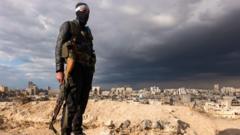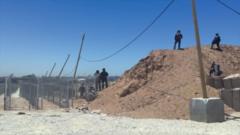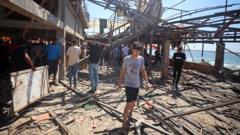Syria faces a critical environmental crisis as relentless wildfires consume vast areas, compounding the struggles of a nation already battered by war.
Wildfires Ravage Syria Amidst Decades-Long Drought

Wildfires Ravage Syria Amidst Decades-Long Drought
Severe drought conditions have set the stage for devastating wildfires across Syria's landscapes.
Syria is currently engulfed in a catastrophic wildfire crisis, with over 14,000 hectares of land—equivalent to the size of Washington, D.C.—reduced to ashes in just six days. The wildfires are primarily concentrated in the mountainous Latakia region, along the Mediterranean coast, where months of extreme heat and minimal rainfall have rendered forests extremely vulnerable. Meteorologists and aid organizations have labeled this drought as the worst Syria has faced in decades, exacerbating the already dire situation.
The United Nations reports that thousands of Syrians have been impacted by these fires, prompting hundreds of families to evacuate their homes. This environmental disaster signals yet another trial for Syria's new leadership, as the nation strives to regain stability after enduring a brutal 13-year civil war.
The Syrian Civil Defense, known as the White Helmets, is at the forefront of efforts to manage and combat the wildfires, a stark shift from their previous role of rescuing survivors from the devastation of airstrikes in rebel-held territories. However, years of harsh Western sanctions against the Assad regime and the decline of infrastructure have severely hindered their capabilities. Firefighting operations are plagued by a lack of essential resources, including diesel fuel and spare parts for fire trucks, compounded by the treacherous terrain still littered with unexploded ordnance from the ongoing conflict.
Meanwhile, the coastal area—historically a bastion of Assad support and home to a significant portion of Syria's Alawite minority—is facing rising instability. This region was recently the site of horrendous sectarian violence, resulting in the loss of approximately 1,600 lives, predominantly Alawites. The wildfires, therefore, not only threaten the environment but also highlight the precarious social fabric of a country grappling with a myriad of crises.
The United Nations reports that thousands of Syrians have been impacted by these fires, prompting hundreds of families to evacuate their homes. This environmental disaster signals yet another trial for Syria's new leadership, as the nation strives to regain stability after enduring a brutal 13-year civil war.
The Syrian Civil Defense, known as the White Helmets, is at the forefront of efforts to manage and combat the wildfires, a stark shift from their previous role of rescuing survivors from the devastation of airstrikes in rebel-held territories. However, years of harsh Western sanctions against the Assad regime and the decline of infrastructure have severely hindered their capabilities. Firefighting operations are plagued by a lack of essential resources, including diesel fuel and spare parts for fire trucks, compounded by the treacherous terrain still littered with unexploded ordnance from the ongoing conflict.
Meanwhile, the coastal area—historically a bastion of Assad support and home to a significant portion of Syria's Alawite minority—is facing rising instability. This region was recently the site of horrendous sectarian violence, resulting in the loss of approximately 1,600 lives, predominantly Alawites. The wildfires, therefore, not only threaten the environment but also highlight the precarious social fabric of a country grappling with a myriad of crises.




















